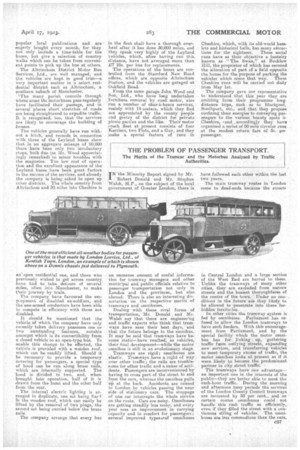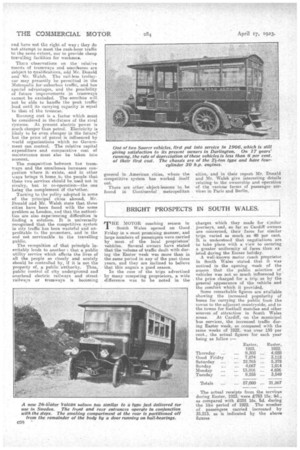THE PROBLEM OF PASSENGER TRANSPORT,
Page 21

Page 22

If you've noticed an error in this article please click here to report it so we can fix it.
The Merits of the Tramcar and the Motorbus Analysed by Traffic Authorities.
TN-the Minority Report signed by Mr. -1 Robert Donald and Mr. Stephen Walsh, -M.P., on the subject of the local government of Greater London, there is
an immense amount of useful information for tramway managers and other -municipal and public officials relative to passenger transportation not only in Loudon and the provinces, but also abroad. There is also an interesting dissertation on the respective Merits of tramways and omnibuses.
Dealing with these rival forms of transportation, Mr. Donald , and Mr. WaLsh say that there are engineering and traffic experts who think that tramways have seen their best days, and that the future belongs to the omnibus. It may he said that tramways have become static—have -reached, as vehicles, their final development—while the motor omnibus is still in an evolutionary stage.
Tramways are rigid; omnibuses are elastic_ Tramways have a right of way over other traffic ; the rails are troublesame for other traffic and a cause of.accidents. Passengers are inconvenienced by having to cross part of the street to and from the cars, whereas the omnibus pulls up a the herb. Accidents are caused in London bv vehicles passing the near aide of stationary cars. The stoppage of one car interrupts the whole service on the route. Cars are noisy. Omnibuses are getting steadily less noisy, and every year sees an improvement in carrying capacity and in comfort for passengers; several improved typeseof omnibuses
have followed each other within the last two years.
The main tramway routes in London come to dead-ends because the streets
in Central London and a large section of the West End are barred to them. Unlike the tramways of many other cities, they are excluded from narrow streets and the busiest thoroughfares of the centre of the town. Under no con. ditions in the future are they likely to be allowed to penetrate into these forbidden territmics.
In other cities the tramway system is fed hr omnibuses. Parliament has refused to allow the London tramways to have such feeders. With this encouragement from Parliament, and by the special facility which the motor °ranibus has for linking up, gathering traffic fawn outlying streets, expanding new serVices, and transferring vehicles to meet, temporary excess of traffic, the motor omnibus looks at present as if it were likely to 'become the predominant partner in city street traffic.
The tramways have one advantage— an important one in the interests of the public—thek are better able to meet the rush-hour traffic. During the morning and afternoon busy periods the services of the London County Council tramways are increased by SO per cent., and on certain routes omnibuses could not handle this rush traffic so efficiently, even if they filled the street with a'contionima string of vehicles. The omnibuses are less commodious than the cars,
arid have not am right of way ; they do not attempt to meet the rush-hour traffic to the same extent, nor to provide cheap travefling facilities for wor.mea.
Thena observations on the relative merits of tramways and umnibuses are subject to qualifications, add Mr. Donald andMr. Walsh. The rail-less trolley
ear may presently be permitted in the Metropolis for-suburban traffic, and has special advantages, and the possibility
of future improvements in tramways cannot be excluded. The cm-nib-Ps will
• not be able to handle the peak traffic *Pad until its carrying capacity is equal to that of the tramcar.
Running. cost is a factor which mtist be considered in thc4uture of the rival
systems. At present electric power is much cheaper than petrol. Electricity is likely to be even cheaper in the future: but the price of petrol is influenced by world organizations -which no Government can control. The relative capital expenditure and comparative cost of maintenance must also be taken into account.
The competition between the tramways and the omnibuses increases con eestion where it.• exists, and in other avays brings it home to the people. that these two services should be used not in rivalry, but in co-operation—the one being the complement of theother.
Turning to the policy adopted in some of the Principal cities abroad, Mr.
Donald and Mr. Walsh state that, these cities have been faced with the same problem as London, and that the authori ties are also expe:iencing difficulties in finding a solution. it is universally recognized that the competitive system in city traffic has been wasteful and unprofitable to the promoters, and in the end not serviceable to the travelling public. The recognition of that principle inevitably leads to another : that a public utility service which affects the lives of all the people so closely and acutely should be controlled by, if it is not the property of, a public 'authority. Thus, public control of city underground and overhead electric railways and street railways or tramways is becoming general in American cities, wheiie the competitive system has worked itself out There are other object-lessons to be found in Continental . metropolitan cities, and in their report, Mr. Donald and Mr. Walsh give interesting details relating to the ownership and operation of the various forms of passenger services in Paris and Berlin.






























